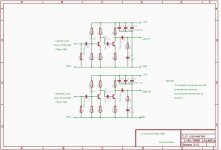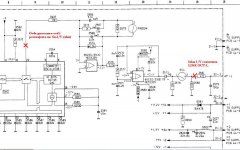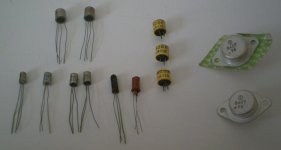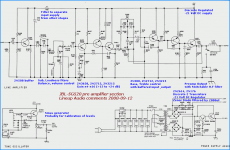@tvicol
I'm interested in your version with GERMANIUM trasistor!! I'm a fan of Ge transistors, I asked many people in my country to make exactly what you do, but without any success... So, PLEASE, can you post me YOUR shematics?
my mail is germanijum@yahoo.com
thx
viccpa
I'm interested in your version with GERMANIUM trasistor!! I'm a fan of Ge transistors, I asked many people in my country to make exactly what you do, but without any success... So, PLEASE, can you post me YOUR shematics?
my mail is germanijum@yahoo.com
thx
viccpa
My friend made, among other things with Ge transistors, this I/V converter for Philips CD104…
It sounds incredible!!!
you can find all the details here...(text is in Serbinan!),
http://germaniumsound.com/forum/viewtopic.php?f=26&t=35
It sounds incredible!!!
you can find all the details here...(text is in Serbinan!),
http://germaniumsound.com/forum/viewtopic.php?f=26&t=35
Attachments
Sometimes I wish I could read Polish/ Chineese/ Japaneese/ Russian etc.....
In the diagram, The second transistor , T2/T4, does not have any bias.
I assume that it is a repeat of the first stage?
I also like the note re. operating temperatures !!!!!
Andy
In the diagram, The second transistor , T2/T4, does not have any bias.
I assume that it is a repeat of the first stage?
I also like the note re. operating temperatures !!!!!
Andy
poynton said:In the diagram, The second transistor , T2/T4, does not have any bias.
I assume that it is a repeat of the first stage?
I wil try to translate the explanation...
Transistor bias is controlled trough inverted (polarization) capacitor, this way the operating “class” of germanium transistor is controlled by his current “leaking”…
Unlike Silicium transistors, this is posible with Germanium transistors, and works very, very well…
bata bane said:
I wil try to translate the explanation...
Transistor bias is controlled trough inverted (polarization) capacitor, this way the operating “class” of germanium transistor is controlled by his current “leaking”…
Unlike Silicium transistors, this is posible with Germanium transistors, and works very, very well…
😉
I have a bunch of ultra-high-frequency AF138 germanium transistors, and some ASY29 ones too, would it be possible to make anything listenable with them?
we tried a bunch of different transistors (2sb75, 2sb77, 2sa15, 2sa17), with not so great results, but with small modifications it probably work, try it.
Slightly OT.....
Is it a simple matter to substitute (replace for repair) an equivalent silicon device, for the old germanium device ?
I'm repairing some older test gear, and the germanium transistors are very hard to find.
(I am looking for some 2n508a, 2n1306, 1307 germaniums.....or modern silicon equivalents.)
thanks,
=RR=
Is it a simple matter to substitute (replace for repair) an equivalent silicon device, for the old germanium device ?
I'm repairing some older test gear, and the germanium transistors are very hard to find.
(I am looking for some 2n508a, 2n1306, 1307 germaniums.....or modern silicon equivalents.)
thanks,
=RR=
I have plenty of 2N1309 germaniums. Tested and guaranteed to be low leakage and with good gain. Top quality.
I also just bought a couple hundred AC128s but they have not arrived yet so I'm not sure how they will test out. The last AC128s that I bought were okay for leakage but low gain and I had to toss a lot of them when sorting, which is typical.
http://www.muzique.com/
Best regards, Jack
I also just bought a couple hundred AC128s but they have not arrived yet so I'm not sure how they will test out. The last AC128s that I bought were okay for leakage but low gain and I had to toss a lot of them when sorting, which is typical.

http://www.muzique.com/
Best regards, Jack
redrabbit said:Slightly OT.....
Is it a simple matter to substitute (replace for repair) an equivalent silicon device, for the old germanium device ?
Short answer... no, not without rebiasing.
regards, Jack
Would any of you say Germaniums are inherently "unreliable" and do you find they suffer from any changes in characteristics due to ageing etc if used correctly.
I have grown up with silicon, and apart from the first amp I ever made (which used AD149 outputs ) I have never used them seriously. There isn't much available now, so I guess it's all a bit academic, although I have a bag of "oldies" somewhere.
I have grown up with silicon, and apart from the first amp I ever made (which used AD149 outputs ) I have never used them seriously. There isn't much available now, so I guess it's all a bit academic, although I have a bag of "oldies" somewhere.
Not really.
I built and modded several amps in the late '60s using OC35s and OC28s, including paralleled outputs in both transformer push-pull and quasi-comp.
I can only think of one instance where I had a problem. That was a 50watt disco amp which started to overheat and distort after 4 hours. The heatsink was too hot to touch - spit sizzled !!!!!! I backed the volume down a bit and put a fan across the HS.
Of course, any transistor in a glass case had to be watched as they are photocells if the black paint gets scratched. OC44/45 etc
I used all sorts from Mullard, GET even Uncle Clives magic rebrands
Andy
I built and modded several amps in the late '60s using OC35s and OC28s, including paralleled outputs in both transformer push-pull and quasi-comp.
I can only think of one instance where I had a problem. That was a 50watt disco amp which started to overheat and distort after 4 hours. The heatsink was too hot to touch - spit sizzled !!!!!! I backed the volume down a bit and put a fan across the HS.
Of course, any transistor in a glass case had to be watched as they are photocells if the black paint gets scratched. OC44/45 etc
I used all sorts from Mullard, GET even Uncle Clives magic rebrands
Andy
Getting back to preamps...
Most old style germanium preamps followed a standard format....
no emitter resistor, collector resistor and a resistor from B to C.
I wondered recently, when this thread re-appeared, would there be any benefit in using a modern symmetrical, balanced, diamond approach ?????
I do not recollect seeing anything like this in germanium.
Anyone..........
Andy
Most old style germanium preamps followed a standard format....
no emitter resistor, collector resistor and a resistor from B to C.
I wondered recently, when this thread re-appeared, would there be any benefit in using a modern symmetrical, balanced, diamond approach ?????
I do not recollect seeing anything like this in germanium.
Anyone..........
Andy
I remember the paint problem, in fact wasn't the OCP71 (was it ?) just an unpainted OC71. Funny things come back to you. The paint passes I/R radiation I think I remember reading. Some product/project can't remember now had a problem that was down to flourescent lights interfering with it. The cure was to shield an OC71 from light totally.
I have a GET101 I think it is somewhere ( in a very soft "copper" type metal case ) and assorted 2SA, 2N's etc and some BA ? numbers in a bakelight type material with yellow rubber sleeving over them. Happy days ?
I have a GET101 I think it is somewhere ( in a very soft "copper" type metal case ) and assorted 2SA, 2N's etc and some BA ? numbers in a bakelight type material with yellow rubber sleeving over them. Happy days ?
I seem to remember seeing ex-computer boards with those on in the late '60s from Shudehill in Manchester or maybe New Cross.
I just Googled ... double diodes
http://www.vintage-radio.net/forum/showthread.php?t=10976 post 10
Andy
I just Googled ... double diodes
http://www.vintage-radio.net/forum/showthread.php?t=10976 post 10
Andy
Thanks for that. Now I've never worked on a 405 line set, Decca Bradfords were just about coming to the end of their life when I started out. Happy days 🙂
Re: Some of my treasures,
yeah, as told
may of those BAxxx are often silicon diodes
Mooly said:It was a GET114 not a 101 🙂
Those BA116 are weird things, anyone know what they are or were used in ?
yeah, as told
may of those BAxxx are often silicon diodes
JBL SG520 Audio Amplifier
http://www.jblproservice.com/pdf/Vintage JBL-UREI Electronics/JBL-SG520.pdf
thanks, Netlist 😎
Lineup Audio LAB verdict:
JBL SG520 pre amplifier circuit
- Just great! Very High Quality, with today's standards,
.. eventhough being 'very old' amplifier.
See my detailed comments in circuit.
My Attachment, here below.
Enjoy 🙂
Lineup Audio Amp Reviews
.....
Netlist said:That's an easy one:
JBL-SG520.pdf
Warning: 8.8 MB !!!
/ Hugo
janneman said:Hugo, I'll buy you a beer anytime we meet!
But you are right, maybe I should have more fun.
/ Jan Didden
http://www.jblproservice.com/pdf/Vintage JBL-UREI Electronics/JBL-SG520.pdf
thanks, Netlist 😎
Lineup Audio LAB verdict:
JBL SG520 pre amplifier circuit
- Just great! Very High Quality, with today's standards,
.. eventhough being 'very old' amplifier.
See my detailed comments in circuit.
My Attachment, here below.
Enjoy 🙂
Lineup Audio Amp Reviews
.....
Attachments
- Home
- Amplifiers
- Solid State
- germanium Preamp?



